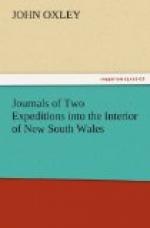August 26.—At eight o’clock we proceeded on our course towards Bathurst. The country throughout the day’s journey was extremely hilly, with steep descents into fine valleys, in every one of which was a running stream. It appeared to me, that we were pursuing a course which, intersecting the streams near their sources, rendered our road much more irregular and difficult than it would have been either a few miles farther westward, or even on the immediate banks of the river, the line of which we several times saw during the day. The country north-east of the river was very elevated and broken. The tops and sides of even the most mountainous parts were covered with grass, and thinly clothed with wood.
Many of the valleys were composed of extremely rich soil: the hills were also generally good land and covered with grass; though there were occasionally barren stony summits, and ridges producing nothing but iron and stringy bark trees of diminutive growth. These tracts were however too inconsiderable in extent, to be considered other than what ought naturally to be expected in such an irregular tract as that which we travelled over.
Had not the appearance of the country round the Macquarie, where we first reached it, fully accounted for its magnitude, the course we have pursued since would satisfactorily have explained the cause; it is in point of fact a country of running waters: on every hill we found a spring, and in every valley a rivulet, either flowing directly north-east to the river, or taking a course westerly to join the river in Wellington Vale. Of the waters that may fall into it from the north-east we were of course ignorant, but the appearances of the country indicated that they were at least as numerous as from the south-west.
After proceeding a few miles, we halted for the night in an extensive valley, watered by a rivulet running through it directly to the river, from which I think we were distant six or seven miles.
August 27.—Nothing could be more delightful than the climate and the temperature of the season.
At eight o’clock we took our road through a very rugged and broken country. The glens were enclosed on either side by almost perpendicular rocks, mostly slate of fine quality, mixed with coarse granite. In these glens or defiles were fine running streams. The declivity and steepness of the road delayed our progress, in seeking for better paths for the horses; and after riding a few miles we came to the edge of a very steep glen or valley, at the point of junction of two large streams, the largest coming from the south-west, the other from the north-west. Both united formed a very powerful stream, rushing with great impetuosity over a rocky bottom, with frequent falls or rapids. The hills being on both sides too steep even for the men to descend in safety, we were obliged to pursue the ridge of them up the north-west river, until we found a place where we could descend




